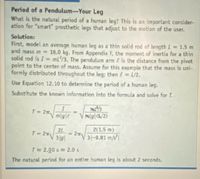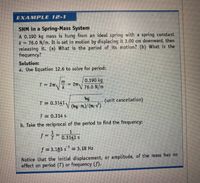Question
Consider a pendulum clock with a 0.1651 m pendulum with a 56.7 g pendulum weight. If you converted the pendulum system into a mass-spring system, what would the spring constant be?
(In the image are two possible formulas)

Transcribed Image Text:Period of a Pendulum-Your Leg
What is the natural period of a human leg? This is an important consider-
ation for "smart" prosthetic legs that adjust to the motion of the user.
Solution:
First, model an average human leg as a thin solid rod of length L
and mass m 16.0 kg. From Appendix F, the moment of inertia for a thin
solid rod is I mL/3. The pendulum arm is the distance from the pivot
point to the center of mass. Assume for this example that the mass is uni-
formly distributed throughout the leg; then L/2.
= 1.5 m
Use Equation 12.10 to determine the period of a human leg.
Substitute the known information into the formula and solve for T..
T= 2m
mgle
V lg|/2)
= 2T
T-2V3191
2L
3|g|
2(1.5 m)
31-9.81 m/s
T 2.00 s= 2.0 s
The natural period for an entire human leg is about 2 seconds.

Transcribed Image Text:EXAMPLE 12-1
SHM in a Spring-Mass System
A 0.190 kg mass is hung from an ideal spring with a spring constant
k 76.0 N/m. It is set in motion by displacing it 3.00 cm downward, then
releasing it. (a) What is the period of its motion? (b) What is the
frequency?
Solution:
a. Use Equation 12.6 to solve for period:
T= 2TTK
0.190 kg
76.0 N/m
=2T
kg
(kg-m.)/(m-s)
(unit cancellation)
T 0.3141.
A,
T 0.314 s
b. Take the reciprocal of the period to find the frequency:
f==0.3141 s
f= 3.183 s = 3.18 Hz
Notice that the initial displacement, or amplitude, of the mass has no
effect on period (T) or frequency (f).
Expert Solution
arrow_forward
Step 1
hey dear this question is from classical mechanics by equating time period of pendulum and mass spring system we calculated the spring constant . Have a look
Step by stepSolved in 2 steps with 1 images

Knowledge Booster
Similar questions
- The diagram shows a horizontal spring attached to a block. The block’s equilibrium position is at C, and the block oscillates between the points A and E with no friction from the floor. As the block moves from C to E, which of the following statements is true? Usp is the spring potential energy of the spring and K is the kinetic energy of the block. Usp decreases, K decreases Usp stays the same, K stays the same Usp decreases, K increases Usp increases, K decreases Usp increases, K increasesarrow_forwardRefer to the picture belowarrow_forwardA 2.38 kg ball is attached to an unknown spring and allowed to oscillate. The figure shows a graph of the ball's position x as a function of time t. What is the force constant of the spring?arrow_forward
- A horizontal spring attached to a wall has a force constant of 720 N/m. A block of mass 1.90 kg is attached to the spring and oscillates freely on a horizontal, frictionless surface as in the figure below. The initial goal of this problem is to find the velocity at the equilibrium point after the block is released. (a) What objects constitute the system, and through what forces do they interact? (b) What are the two points of interest? (c) Find the energy stored in the spring when the mass is stretched 6.40 cm from equilibrium and again when the mass passes through equilibrium after being released from rest. x = 6.40 _____ J x = 0 ______J (e) Substitute to obtain a numerical value. (f) What is the speed at the halfway point?arrow_forwardPlease answer this University Physics Question.arrow_forwardA block of mass m = 1 kg is attached a spring of force constant k = 500 N/m as shown in the figure below.The block is pulled to a position x = 10 cm to the right of equilibrium and released from rest. The horizontalsurface is frictionless.(a) What’s the period of block’s oscillation? (b) Find the speed of the block as it passes through the equilibrium point x = 0. (c) Please represent block’s motion with the displacement vs. time function x(t) and draw the motiongraph x(t) for at least one periodic cycle. Note, please mark the amplitude and period in the motiongraph. Assume the clock starts from when the block is just released. (d) Please find out the block’s velocity and acceleration at t = 0.14s.arrow_forward
- Please answer questions 3, 4 and 5! A 780 g object is hung from a spring with a force constant of 30 N/m. What is the displacement of the spring from equilibrium length if it is hanging vertically Now, the mass in question a is being pulled downward by an additional 9 cm. What is the potential energy? You release the object, what is the period of oscillation of the mass/spring system? Using yt=Acos(wt), what is the expression of the vertical motion along the y-axis? What is the maximum speed of the oscillating object? What is the maximum kinetic energy? Do these values make sense from the values in part b?arrow_forwardA 0.20 kg ball is tied to a string. It is pulled to an angle of 8.00º and released to swing as a pendulum. At student with a stopwatch finds that 10 oscillations take 12 s. How long is the string? Use g = 10 m/s/s.arrow_forwardThe figure blow shows the kinetic energy of a simple pendulum versus its angle θ from the vertical. Note the energy units are in milli-joules. The vertical axis is set by Ks=4mJ and the mass of the pendulum bob is 0.200 kg. Determine the length of the pendulum in meters. Use g = 9.8 N/kg.arrow_forward
arrow_back_ios
arrow_forward_ios